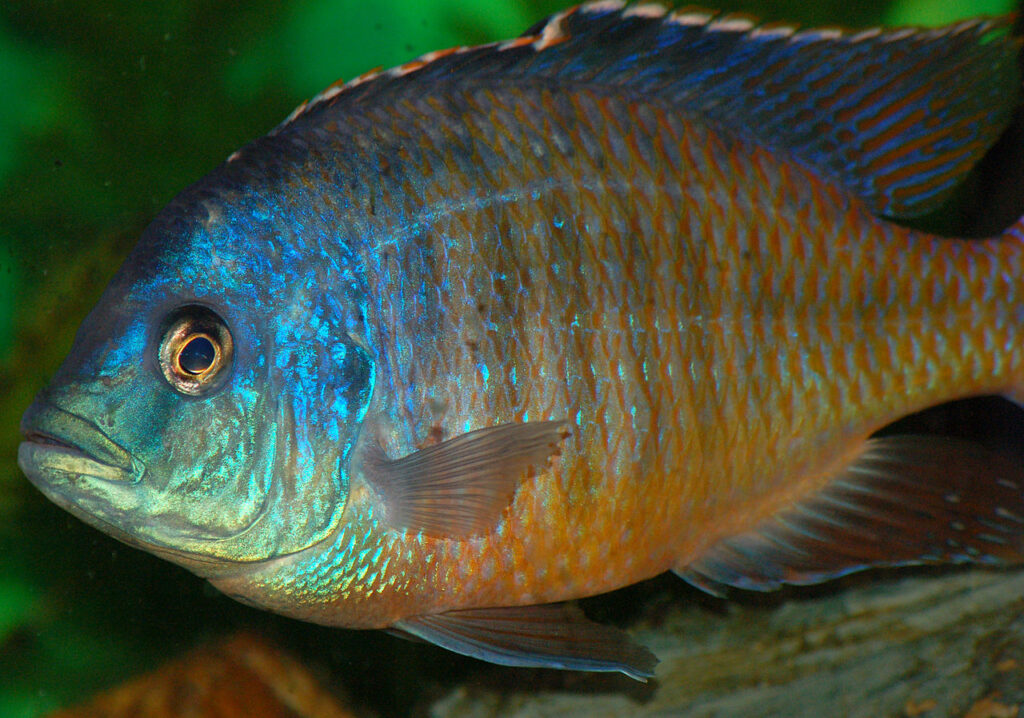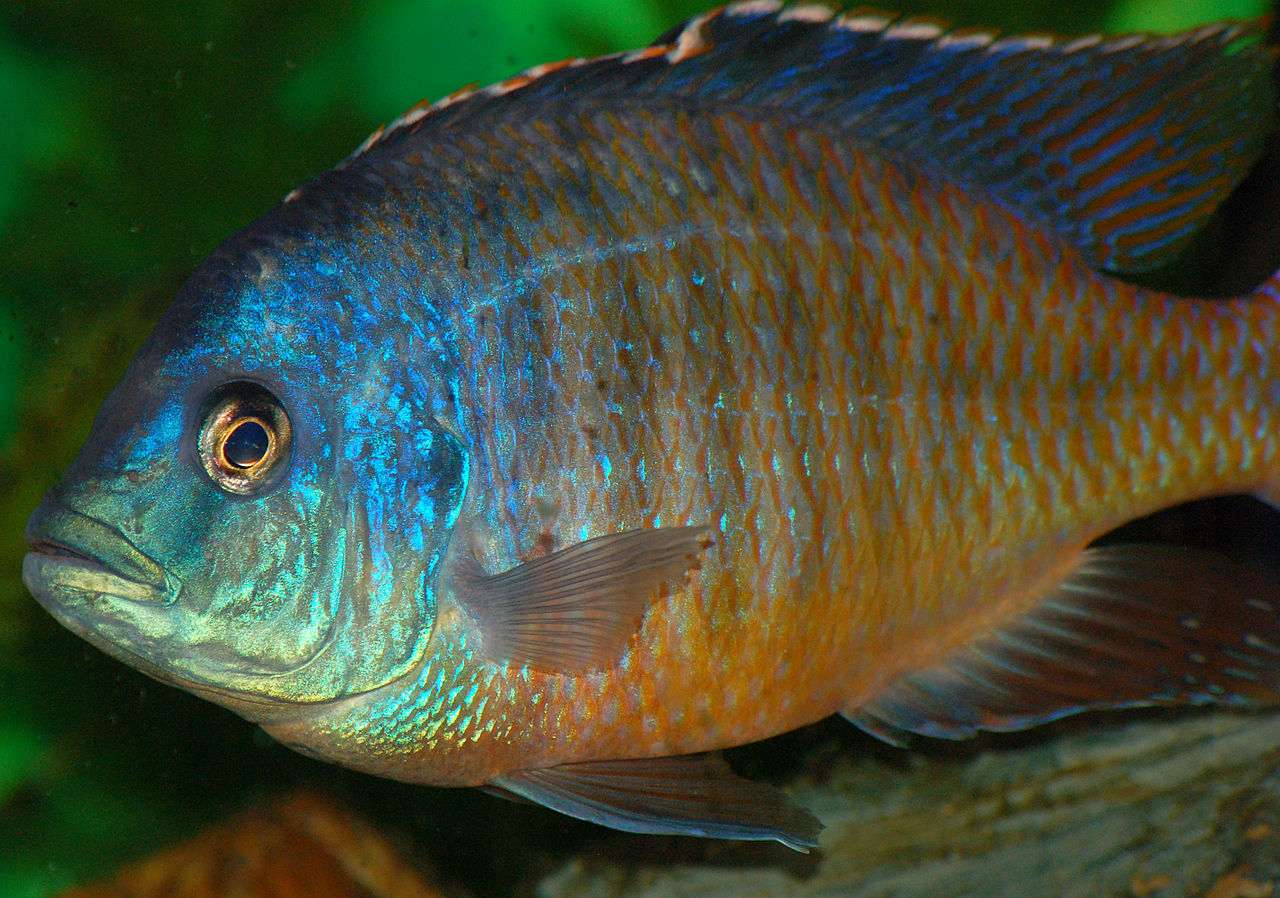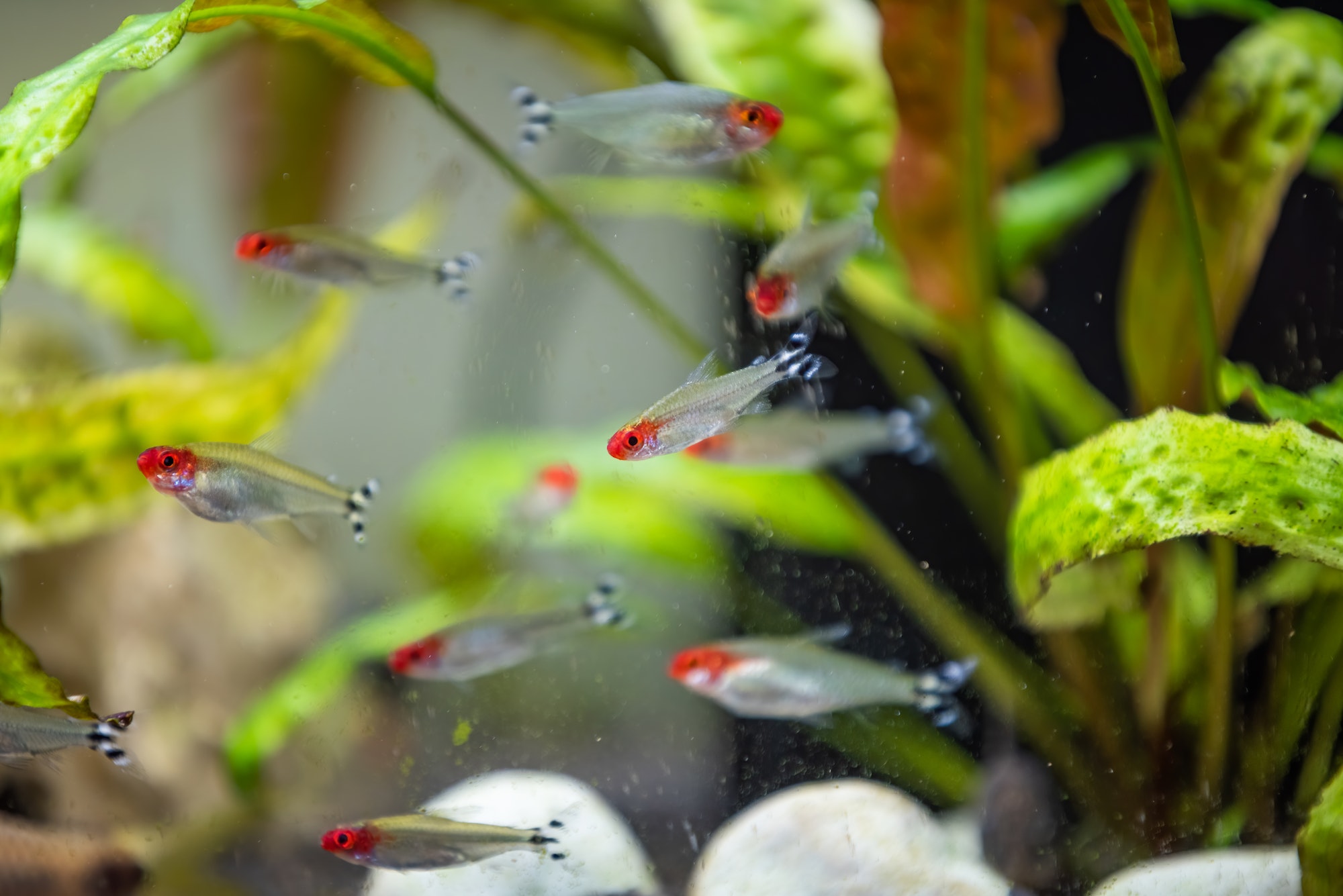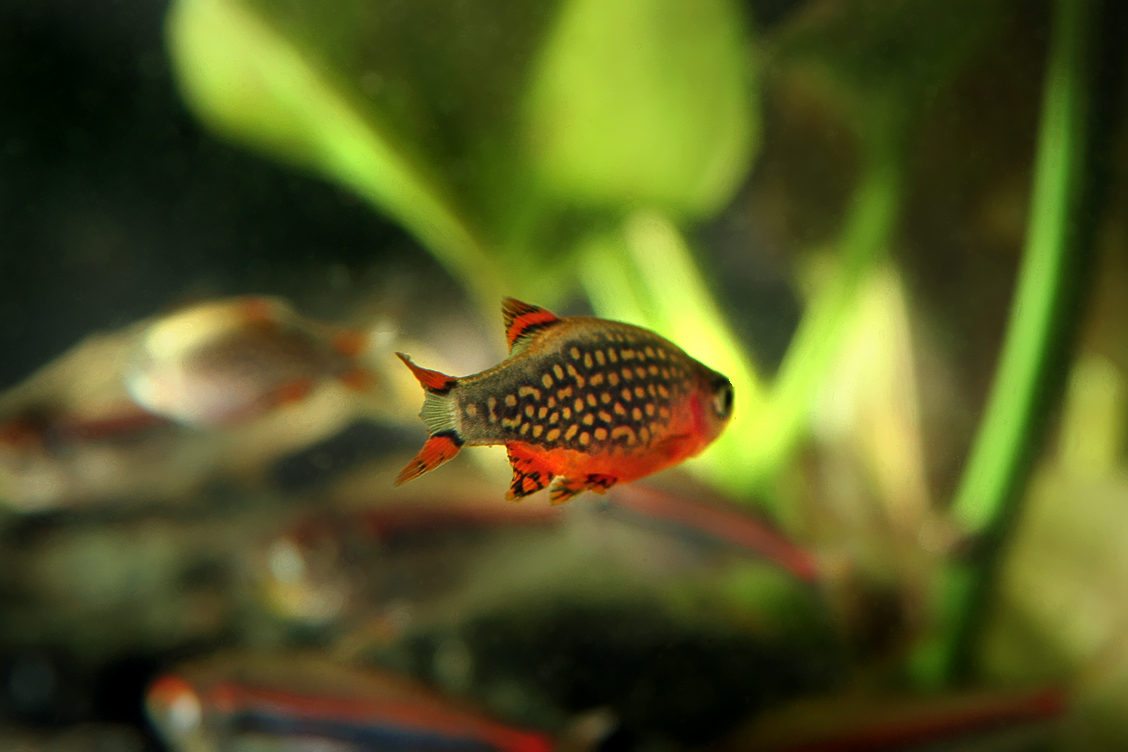Nestled within the aquarist community, the Red Empress Cichlid, or Protomelas taeniolatus, is a sight to behold. This freshwater marvel hails from the diverse Cichlidae family, sharing its lineage with a myriad of African cichlids from Lake Malawi’s clear waters. The males are a canvas of nature’s finest art, with splashes of red, blue, and orange, while females wear a more conservative attire of grey or brown.
Table of Contents
The backdrop of their history is as riveting as their colors. These fish emerged from the African Rift Valley’s aquatic cradle, Lake Malawi, renowned for its biological diversity. It’s here, in the ninth largest lake in the world, that the Red Empress Cichlid’s tale begins, weaving its way into the hearts of fish keepers over several decades.
These cichlids are anything but elusive in their natural habitat and are equally within reach for hobbyists. They aren’t as prevalent as some other Malawi cichlids in the trade, but they’re far from rare, offering a touch of exotic charm without the scarcity.
The Red Empress Cichlid’s preferred quarters are neither the sandy floor nor the water’s shimmering surface but the mid-level strata, swimming amongst the rocks. They are as versatile in their diet as they are in their swimming, taking to both animal and plant-based foods with gusto. This omnivorous palate helps maintain their striking colors, which are especially vibrant during breeding when males dress to impress.
Speaking of temperament, they are the embodiment of tranquility, though males might puff their chests over territories or potential mates. Their peaceful nature makes them an excellent community fish, ideal for sharing space with other non-aggressive tank mates.
The living parameters for these cichlids align closely with their home in Lake Malawi, with warmer waters and alkaline conditions being the gold standard for their care. They can grow to a respectable six inches and live a full decade with proper care, making them long-term companions for dedicated aquarists.
A fascinating tidbit about the Red Empress Cichlid is their cognitive acuity; they can recognize their human caretakers, which fosters a unique bond between fish and aquarist. It’s not just their looks that are impressive but also their brains, adding to the joy of keeping them.
With their African origins, the Red Empress Cichlid carries the essence of Lake Malawi to home aquariums, creating a lively and colorful aquatic scene. They are not just pets; they are a portal to an underwater world, offering a slice of the wild to those who care for them.

Key Information
The Red Empress Cichlid, a vibrant inhabitant of freshwater aquariums, is renowned for its stunning coloration and relatively peaceful demeanor. While it doesn’t have a wide range of recognized variants, individual specimens can show a remarkable diversity in color patterns. These variations are largely influenced by genetics, diet, and environmental conditions. The male Red Empress Cichlid, especially, is known for its striking appearance, which can include shades of red, orange, and blue. The females, generally less colorful, tend towards muted browns or greys. Understanding these nuances is essential for aquarists who aim to showcase the beauty and diversity of these magnificent fish in their aquariums.
| Family | Cichlidae |
| Price | $20 to $50, depending on size and coloration |
| Common Names | Red Empress Cichlid, Spindle Hap, Haplochromis Red Empress |
| Variants | Color variations, predominantly in males |
| Ideal Tank Size | Minimum 55 gallons |
| Water Parameters | Temperature: 76-82°F (24-28°C), pH: 7.8-8.6 |
| Lifespan | Up to 10 years |
| Full Size | Up to 6 inches (15 cm) |
| Natural Environment | Lake Malawi, Africa |
| Behavior | Peaceful, can be territorial during breeding |
| Habitat Preference | Mid-water near rocky formations |
| Aquarium Decoration | Rocks, caves, and open swimming spaces |
| Ideal Tank Mates | Other African cichlids of similar size and temperament |
| Fish to Avoid | Small, timid, or overly aggressive species |
| Best Foods/Diet | Omnivorous; a mix of vegetable-based foods and occasional protein (e.g., spirulina, brine shrimp) |
| Disease | Susceptible to common freshwater ailments; good water quality is crucial |
| Sex-Switch | Rare, but possible under stress or in imbalanced populations |
| Gender Differences | Males are more colorful; females are plainer and smaller |
| Care Level | Intermediate |
| Breeding Level | Moderate; mouthbrooding species |
Ideal Tank Mates
Finding ideal tank mates for the Red Empress Cichlid (Protomelas taeniolatus) involves considering fish that can coexist peacefully with them while thriving in similar water conditions. Red Empress Cichlids, native to Lake Malawi in Africa, are generally peaceful but can be territorial, especially during breeding. They do best with tank mates that are neither too aggressive nor too timid. The ideal companions should be able to hold their own without provoking aggression. Here’s a list of 15 suitable tank mates, explaining why each is compatible with the Red Empress Cichlid.
1. Yellow Lab Cichlid (Labidochromis caeruleus)
These are peaceful, colorful fish that adapt well to the community tank environment. Their calm demeanor makes them suitable companions for Red Empress Cichlids.
2. Acei Cichlid (Pseudotropheus acei)
Known for their peaceful nature, Acei Cichlids are a good match. They share a similar diet and water parameters, making them easy to care for alongside Red Empress Cichlids.
3. Peacock Cichlid (Aulonocara)
Peacock Cichlids are known for their stunning colors and peaceful nature. They share the Red Empress Cichlid’s preference for similar water conditions and diet.
4. Zebra Cichlid (Maylandia estherae)
These cichlids are relatively peaceful and can hold their own without being aggressive. They thrive in the same water conditions as the Red Empress.
5. Bristlenose Pleco (Ancistrus sp.)
Bristlenose Plecos are excellent tank cleaners and are peaceful enough to coexist with Red Empress Cichlids. They occupy different areas of the tank, reducing competition for space.
6. Electric Blue Hap (Sciaenochromis fryeri)
The Electric Blue Hap is a relatively peaceful cichlid that can share a tank with the Red Empress without much conflict, given adequate space.
7. Clown Loach (Chromobotia macracanthus)
Clown Loaches are peaceful and active, and they can help control snail populations. They require similar water conditions and are not territorial.
8. Blue Dolphin Cichlid (Cyrtocara moorii)
These are peaceful and get along well with other non-aggressive cichlids like the Red Empress. They require similar water parameters and diets.
9. Rainbowfish (Melanotaeniidae)
Rainbowfish are peaceful, active, and colorful. They add a different dynamic to the tank and do not compete directly with cichlids for territory.
10. African Red-Eyed Tetra (Arnoldichthys spilopterus)
This species is known for its peaceful temperament and can coexist with Red Empress Cichlids, provided the tank is spacious enough.
11. Giant Danio (Devario aequipinnatus)
Giant Danios are fast swimmers and can evade any mild aggression from cichlids. They require similar water conditions and add activity to the tank.
12. Synodontis Catfish (Synodontis sp.)
These catfish are bottom dwellers and generally keep to themselves. They share a similar habitat preference and are peaceful enough to coexist with Red Empress Cichlids.
13. Malawi Eye-Biter (Dimidiochromis compressiceps)
Despite their name, Malawi Eye-Biters are relatively peaceful and can coexist with other similarly sized cichlids, including the Red Empress.
14. African Butterfly Peacock (Aulonocara jacobfreibergi)
These are another peaceful species of Peacock Cichlid that share similar dietary and environmental needs with the Red Empress Cichlid.
15. Mbuna Cichlids (Various species)
Mbunas can be a good match if chosen carefully. Selecting the less aggressive Mbuna species ensures a harmonious coexistence in a community tank.
These tank mates have been chosen based on their compatibility in terms of temperament, size, dietary needs, and environmental requirements. It’s important to monitor the tank dynamics regularly, as individual temperaments and behaviors can vary.
FAQs
Can Red Empress Cichlids Coexist with Invertebrates?
They can coexist with larger, more robust invertebrates like snails or larger shrimp species. However, small or delicate invertebrates may be at risk.
What Are the Signs of Illness in Red Empress Cichlids?
Common signs include loss of appetite, lethargy, fading colors, and abnormal swimming patterns. Watch for visible spots or lesions on the body, which can indicate infections or parasites.
What Are Some Common Misconceptions About Red Empress Cichlids?
A common misconception is that all cichlids are highly aggressive. While Red Empress Cichlids can be territorial, they are generally more peaceful than many other cichlid species. Another misconception is that they require minimal care; in reality, they thrive best with attentive care and stable tank conditions.
Do Red Empress Cichlids Require Special Lighting in the Aquarium?
Red Empress Cichlids don’t require specialized lighting, but a well-lit tank can enhance their vibrant colors. Standard aquarium lighting that replicates natural daylight cycles is generally sufficient.
What Is the Ideal Group Size for Keeping Red Empress Cichlids?
While they can be kept singly, Red Empress Cichlids thrive in groups. A group of at least six is ideal to promote natural behavior and reduce aggression, especially in a larger tank.
Can Red Empress Cichlids Be Kept in a Planted Tank?
Yes, they can be kept in a planted tank, but choose hardy plant species as they may dig and disrupt delicate plants. Plants also provide additional hiding spots and enrich the environment.
How Do I Know If My Red Empress Cichlids Are Stressed?
Signs of stress include hiding excessively, darting around the tank, faded colors, and reduced feeding. Stress can be caused by poor water quality, inadequate diet, or aggression from tank mates.
What Are the Best Practices for Maintaining Water Quality for Red Empress Cichlids?
Regular water changes (about 20-30% weekly), proper filtration, and avoiding overfeeding are crucial. Test the water regularly for ammonia, nitrite, nitrate, and pH levels to ensure they remain within the ideal range.
Is It Necessary to Use a Heater in the Red Empress Cichlid Tank?
Yes, a heater is important to maintain a consistent temperature between 76-82°F (24-28°C), which is crucial for their health and well-being.
How Can I Enhance the Coloration of My Red Empress Cichlids?
Providing a varied diet rich in nutrients, maintaining optimal water conditions, and ensuring a stress-free environment can help enhance their natural coloration. Some aquarists use color-enhancing fish foods, but these should be used judiciously.







